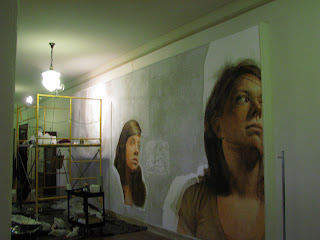I'm still chipping away (literally in some cases) at the fresco. Here are some images showing where the image is today, which takes you all the way to my latest section, a 4.5 foot-tall face (a couple images down). In Sr. Wiley fashion, this face alone is the result of a working session that began at 8am on one day and ended at 5am the next (21 hours total, 12+ were actual painting).
A note: traditionally fresco paintings are completed sectionally in horizontal rows, starting at the top of the mural. This helps ensure that unexpected drips fall onto unfinished portions of the painting, rather then sections that were completed the day before. Despite the logic of this practice, and with great caution, I've chosen to work the figures first, irregardless of their vertical placement. I plan to finish the negative spaces between them, which include transparent echoes of figures towards the end of the fresco.



This is my palette. It includes cups of fresco-safe pigments ground in water. I mix colors (mostly) by layering transparent glazes from this basic set. I use paper towels to control the amount of water in my brush, which helps prevent dripping and allows me to respond to the plaster's changing thirst, with more or less wetness.
Traditionally painters squeeze out excess water and paint from brush with their finger tips. I've opted not to squeeze and instead use paper towels to control the water because some of the pigments are toxic.

The irregular white border around these figures will be carefully chipped away with a sharp chizel before working on sections that bump up to these figures.




Awesome, absolutely awesome!
ReplyDeleteI'm so impressed by this - I'm curious how you managed to get so much painting time out of a single piece of plaster,for the large face?
ReplyDeleteIt's a beautiful piece of work - I'm really inspired by this. Many thanks for posting it
Thank you for your kind remarks Iaincarstairs. I have greatly enjoyed reading your site as well!
ReplyDeleteYou have asked a good question regarding the painting time of the large face and I wonder if you also paint frescoes? Mostly, I work for as long as the plaster is willing to accept paint, which depends on the conditions of the environment (summmer vs winter, wet vs dry weather). When the plaster is in an ideal state the painted marks lock into the plaster instantly and hold firm on the surface unable to be wiped away with a wet brush. At a certain point when the plaster is finished accepting paint, the newest marks refuse to lock into the surface and wipe away easily with a wet brush. It is difficult to explain but the character of the plaster makes a very noticeable change after a certain number of hours.
On many occasions, the plaster was open for painting for 20-24 hours. I suspect it's because I kept the neighboring areas very damp and because Kentucky, where the mural was painted, is very humid.
Again, thank you. I look forward to following your site.
Amazing work!! Congratulations. You worked such long days; it seems akin to running a marathon- but with additional planning, focus, training, talent, and drive! I studied fresco restoration in Italy many years ago- I learned how to paint fresco in Manhattan. I am finally, over 2 decades later, trying my hand at it again. I hope to make it to Kentucky to see your work at the university someday; I live in the Bay Area. Fresco is absolutely my favorite medium due to the translucent quality of the paint that is stunning when fixed into the lime mortar. Thank you for continuing this lineage. Melissa Parhm www.melissaparhmfineart.com
ReplyDelete